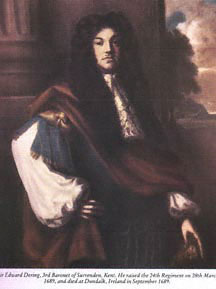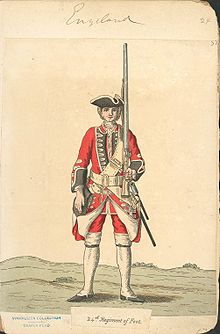South Wales Borderers
[2] The regiment was part of the amphibious expedition to the Caribbean and participated in the disastrous British defeat at the Battle of Cartagena de Indias in March 1741 during the War of Jenkins' Ear.[4] It was also part of the amphibious expedition against, or descent on, the coast of France and participated in the disastrous British defeat at the Battle of Saint Cast in September 1758.The regiment was part of the 5,000 British and Hessian force, under the command of General John Burgoyne, that surrendered to the American rebels in the Saratoga campaign in summer 1777 and remained imprisoned until 1783.The British had pitched camp at Isandlwana and not established any fortifications due to the sheer size of the force, the hard ground and a shortage of entrenching tools.[10] During the battle Lieutenant-Colonel Pulleine ordered Lieutenants Coghill and Melvill to save the Queen's Colour—the Regimental Colour was located at Helpmekaar with G Company.[12] After the battle of Isandlwana, some 4,000 to 5,000 Zulus headed for Rorke's Drift, a small missionary post garrisoned by a company of the 2nd Battalion of the 24th Foot, a few native levies, and others under the command of Lieutenant Chard, Royal Engineers.The Acting Assistant Commissary James Dalton persuaded Bromhead and Chard to stay and the small garrison frantically prepared rudimentary fortifications.The garrison had suffered 15 killed during the battle (two died later) and 11 defenders were awarded the Victoria Cross for their distinguished defence of the post, seven going to soldiers of the 24th Foot.[23] 2nd Battalion arrived in Cape Colony in early February 1900[24] and saw action at the Battle of Elands River in September 1901 during the Second Boer War.[26] The 3rd (Militia) Battalion was embodied in January 1900, and the following month embarked for service in South Africa, arriving in Cape Town on the SS Cheshire in early March 1900.[1][17][30] The 1st Battalion landed at Le Havre as part of the 3rd Brigade in the 1st Division with the British Expeditionary Force in August 1914 for service on the Western Front.It remained in garrison at Mhow until October 1919, supplying reinforcement drafts to the 4th (Service) Bn, SWB, in Mesopotamia and to the units involved in the Third Anglo-Afghan War.[22] Meanwhile, the 2nd Battalion was sent overseas to Barrackpore in India in 1919, being present in Jhansi in 1921,[37] redeploying to Delhi in 1925, Aden in 1927 then returning to garrison Portsmouth in February 1929.The battalion sustained enormous casualties in Libya near Tobruk when they lost around 500 officers and men captured or killed during a general retreat.[40] The battalion found itself cut off when the German forces outflanked them, the Commanding Officer, Lieutenant Colonel Francis Matthews, decided to attempt to escape around the enemy and break through to British lines.[41] In April 1940 the battalion was again transferred to the newly created 24th Guards Brigade (Rupertforce), and took part in the Norwegian Campaign, and were among the first British troops to see action against the German Army in the Second World War.In October, shortly after the failure of Operation Market Garden, the division was sent to garrison the "Island", as the area of land between Arnhem and Nijmegen was known, where it remained throughout the northern winter of 1944/45.[46] It then transferred to the Royal Artillery on 15 November 1941 as 90th Light Anti-Aircraft Regiment,[47] seeing service in Tunisia and Italy with 1st Infantry Division.[49] The regiment deployed to the Sudan in March 1949 and became part of the occupation force in Eritrea, a former Italian colony that was ruled by a British military administration, in January 1950.










Kingdom of EnglandKingdom of Great BritainUnited KingdomBritish ArmyInfantryLine infantryThe Barracks, BreconMen of HarlechRorke's DriftKing Edward VIIIregimentEnglandBreconBrecknockshireMonmouthshireHerefordshireChilders ReformsAmerican War of IndependenceZulu WarSecond Boer WarWorld War IWorld War IIWelch RegimentRoyal Regiment of WalesSir Edward Dering, 3rd BaronetcolonelsDuke of SchombergWilliamite War in IrelandBattle of SchellenbergBattle of BlenheimWar of the Spanish SuccessionCaribbeanBattle of Cartagena de IndiasWar of Jenkins' EarBritish Army order of precedenceSiege of Fort St PhilipMenorcaSeven Years' WarBattle of Saint CastQuebecinvaded the provinceWar of Independence5,000 BritishHessianJohn BurgoyneSaratoga campaignBattle of AbukirBattle of TalaveraPeninsular WarCape ColonyBattle of Blaauwbergaction of 3 July 1810Comoro IslandsEast IndiamenWindhamAnglo-Nepalese WarSecond Anglo-Sikh WarBattle of ChillianwalaVictoria CrossesAndaman IslandsJhelumIndian RebellionColonel William SpringBattle of IsandlwanaAnglo-Zulu WarZululandCetshwayoBuffalo RiverIsandlwanaentrenching toolsLord ChelmsfordcompaniesHenry PulleineCoghillMelvillHelpmekaarVictoria CrossZulu DawnBattle of Rorke's DriftRoyal EngineersGonville BromheadAdendorffJames DaltonCardwell ReformsSouth WalesMilitiaVolunteerRoyal South Wales Borderers MilitiaRoyal Montgomeryshire RiflesBritish IndiaPeshawarLahoreThird Anglo-Burmese WarBattle of Elands RiverVolunteer Service CompanyHaldane ReformsTerritorial ForceSpecial Reserve3rd (Reserve) Bn1st Brecknockshire BnConway Street drill hall, BreconMonmouthshire RegimentLe Havre3rd Brigade1st DivisionBritish Expeditionary ForceWestern FrontLaoshan BayTsingtaoSiege of TsingtaoCape Helles87th Brigade29th DivisionGallipoliMarseillePembroke DockHightownLiverpool44th (Home Counties) DivisionBombayMesopotamiaThird Anglo-Afghan WarKitchener's 1st Army40th Brigade13th (Western) Division58th Brigade